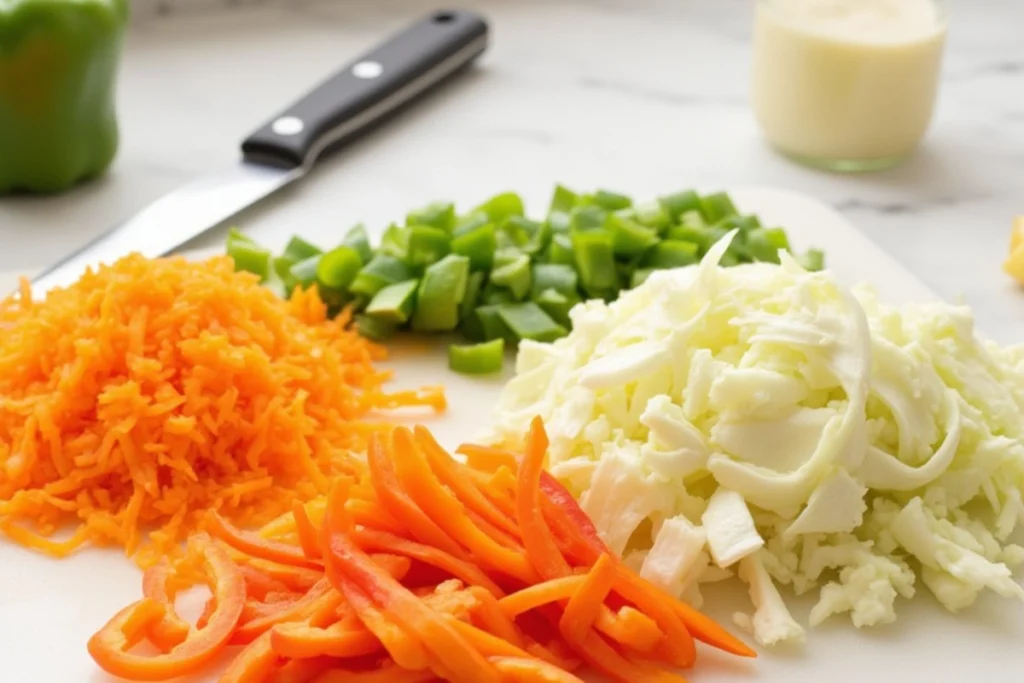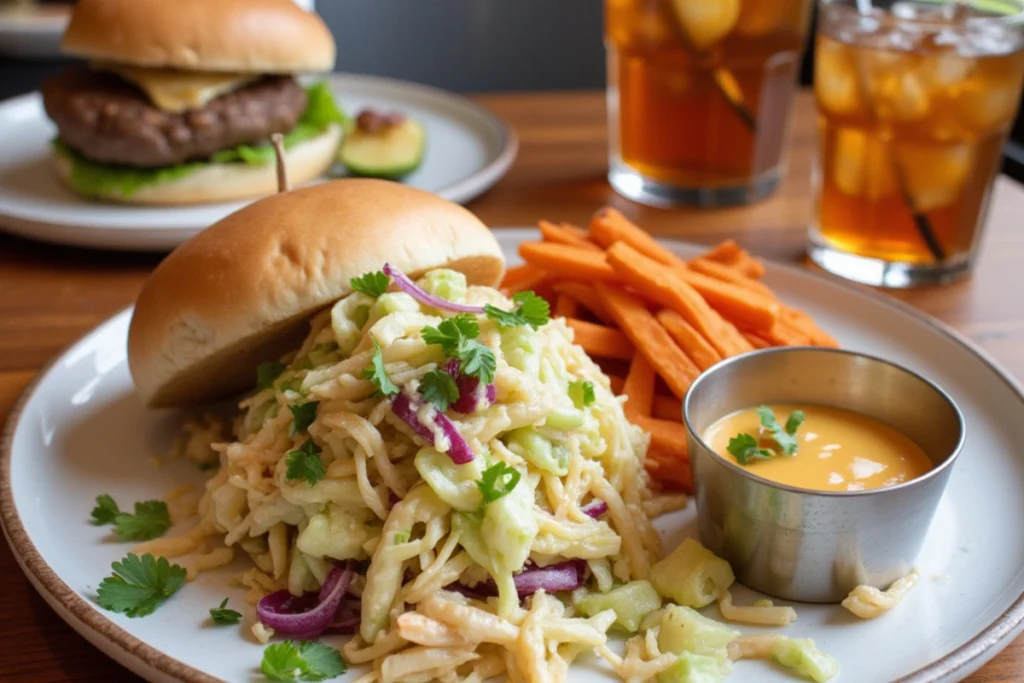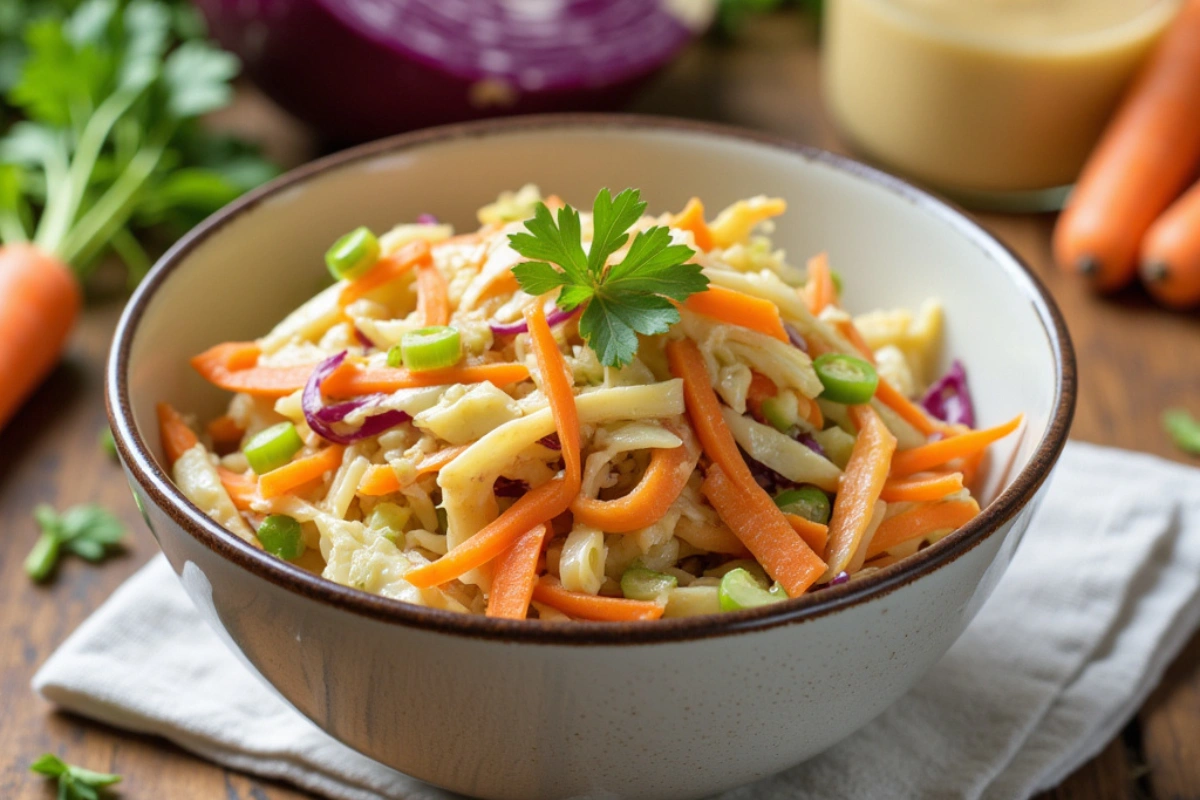introduction
Coleslaw is a timeless favorite, often found at picnics, barbecues, and family gatherings. While traditional coleslaw recipes rely on dairy-based ingredients, this vegan coleslaw recipe provides a plant-based alternative that is creamy, flavorful, and satisfying. Not only is it free of animal products, but it is also healthier and suitable for different dietary needs. Additional plant-based side dishes are highlighted in vegan cabbage recipes and easy vegan coleslaw recipes, both focusing on fresh, nutritious ingredients.
This article includes detailed guidance on making vegan coleslaw. From selecting the freshest vegetables to preparing a creamy vegan dressing, it offers tips, variations, and answers to common questions. Creative versions of this dish can be found in top vegan cabbage recipes, which feature unique approaches to classic coleslaw. Whether you’re a coleslaw enthusiast or looking for a nutritious side dish, this recipe covers everything you need.
What Makes a Coleslaw Recipe Vegan?
Traditional vs. Vegan Coleslaw
Traditional coleslaw relies heavily on ingredients like mayonnaise, cream, or buttermilk to create its rich, tangy dressing. However, vegan coleslaw replaces these with plant-based substitutes, such as vegan mayonnaise or dairy-free yogurt. By omitting animal-derived products, vegan coleslaw becomes a healthier and more inclusive option.
Why Choose a Vegan Coleslaw Recipe?
Vegan coleslaw isn’t just for vegans—it’s for anyone who appreciates a flavorful, versatile side dish. Swapping traditional mayonnaise for plant-based alternatives reduces saturated fat and eliminates cholesterol. These plant-based options, often featured in vegan mayonnaise recipes, contribute to a healthier and more inclusive dish. Additionally, plant-based choices support environmental sustainability, aligning with the growing demand for eco-friendly food options.
With its refreshing crunch and bold flavors, vegan coleslaw works well as a stand-alone side dish or as a complement to meals like vegan BBQ sliders or plant-based burgers. Similar recipes are highlighted in vegan salad recipes, showcasing diverse ways to enjoy plant-based ingredients.
Ingredients for Vegan Coleslaw

Core Vegetables
Cabbage
As the foundation of coleslaw, cabbage provides the perfect base. Whether you choose green cabbage for its mild flavor, red cabbage for its vibrant color, or Napa cabbage for its softer texture, the choice depends on your preference. Finely shredding the cabbage ensures an even blend with the dressing.
Carrots
Carrots add natural sweetness along with a pop of vibrant orange color. By grating or julienning the carrots, they integrate seamlessly into the cabbage mixture and enhance the dish’s overall texture.
Additional Vegetables
For those who enjoy more layers of flavor, consider adding bell peppers, chopped kale, or thinly sliced red onions. These vegetables not only add extra crunch but also elevate the visual appeal of the coleslaw, making it more dynamic.
Vegan Dressing Options
Vegan Mayonnaise
mayonnaise creates the creamy foundation of the dressing. While store-bought versions are widely available, homemade options, often made with aquafaba or cashews, can provide a richer, more personalized flavor.
Dairy-Free Yogurt
If you’re looking for a lighter alternative, unsweetened dairy-free yogurt offers tanginess without adding heaviness to the dish. It’s an excellent option for those seeking a healthier twist on the classic coleslaw dressing.
Apple Cider Vinegar and Mustard
To balance the creamy texture of the dressing, apple cider vinegar adds acidity, while mustard introduces a subtle spiciness. These two ingredients work together to create a tangy and flavorful profile. For further details on the benefits of apple cider vinegar, nutritional benefits of apple cider vinegar provides valuable insights.
Sweeteners and Flavor Enhancers
Maple Syrup or Agave
A small amount of maple syrup or agave syrup can sweeten the dressing naturally, complementing the tangy and savory flavors without being overpowering.
Spices and Seasonings
To bring the flavors together, season the coleslaw with salt, freshly ground black pepper, and a dash of celery seed. Additionally, fresh herbs like parsley or dill can add an aromatic touch, making the dish more vibrant and refreshing.
Step-by-Step Vegan Coleslaw Recipe
Creating the perfect vegan coleslaw recipe is a straightforward process when you follow these simple steps. By combining fresh vegetables with a creamy, tangy vegan dressing, you’ll have a versatile side dish ready in no time.
Ingredients List
Vegetables
- 4 cups of shredded green cabbage (or a mix of green and red cabbage)
- 1 cup of shredded carrots
- ½ cup of thinly sliced red onion (optional)
- ½ cup of thinly sliced bell peppers or chopped kale (optional)
Dressing
- ½ cup of vegan mayonnaise
- 2 tablespoons of unsweetened dairy-free yogurt (optional for a lighter dressing)
- 1 tablespoon of apple cider vinegar
- 1 teaspoon of Dijon mustard
- 1 teaspoon of maple syrup or agave syrup
- ½ teaspoon of celery seed
- Salt and black pepper to taste
Instructions
Step 1: Prepare the Vegetables
First, wash and dry all the vegetables thoroughly. Using a sharp knife, mandoline slicer, or food processor, shred the cabbage into thin strips. Then, grate the carrots. If you’re including red onions or bell peppers, slice them thinly as well. Afterward, place all the vegetables into a large mixing bowl.
Step 2: Make the Vegan Dressing
Meanwhile, in a separate smaller bowl, combine the vegan mayonnaise, dairy-free yogurt, apple cider vinegar, Dijon mustard, and maple syrup. Stir everything well until the dressing becomes smooth and creamy. Additionally, season it with celery seed, salt, and black pepper. If needed, adjust the sweetness or tanginess by adding more maple syrup or vinegar.
Step 3: Combine the Vegetables and Dressing
Next, pour the dressing over the prepared vegetables. Using a large spoon or tongs, toss the mixture thoroughly until the vegetables are evenly coated. As you mix, ensure all the cabbage and carrots are well incorporated with the dressing for consistent flavor.
Step 4: Chill and Serve
After combining, cover the coleslaw and refrigerate it for at least 30 minutes. This step allows the flavors to meld together, making the coleslaw even tastier. Before serving, toss the coleslaw again to refresh its texture. For a final touch, garnish it with fresh parsley or dill.
Nutritional Information (Per 100g)
| Nutrient | Amount |
|---|---|
| Calories | 80 kcal |
| Protein | 1.5 g |
| Fat | 5 g |
| Carbohydrates | 7 g |
| Fiber | 2 g |
| Sodium | 120 mg |
Variations of Vegan Coleslaw
Vegan coleslaw is an incredibly versatile dish that can be customized to suit different tastes and occasions. By experimenting with ingredients and flavors, you can create unique variations that add a new twist to this classic side dish. Here are some creative options to inspire your next coleslaw creation.
Spicy Coleslaw
If you enjoy a kick of heat, spicy coleslaw is an excellent choice. For extra spice, add thinly sliced jalapeños or a pinch of chili flakes to the mix. Furthermore, you can stir a dash of hot sauce or sriracha into the vegan dressing to enhance the spiciness. This variation pairs perfectly with smoky plant-based barbecue dishes or even vegan tacos, providing a bold contrast.
Asian-Inspired Coleslaw
For a tangy and savory twist, an Asian-inspired coleslaw brings a delightful variation. Instead of vegan mayonnaise, sesame oil and soy sauce serve as the dressing base, delivering a rich and nutty flavor. Incorporating rice vinegar adds acidity and balance, enhancing the overall taste profile. For texture, shredded red cabbage, carrots, and green onions provide crunch and vibrant color. To finish, sesame seeds and a drizzle of tamari or hoisin sauce contribute additional umami, creating a dish reminiscent of flavors found in vegan Asian-inspired recipes.
Fruity Coleslaw
Adding fruits to coleslaw results in a sweet and refreshing variation. For example, diced apples, pineapple chunks, or raisins provide bursts of sweetness while adding exciting texture. Moreover, this version pairs well with vegan sandwiches or wraps, offering a balanced and light side dish.
Oil-Free Coleslaw
If you’re looking for a low-fat option, consider making an oil-free coleslaw. Replace vegan mayonnaise with blended avocado or silken tofu, both of which create a creamy texture. Then, add a splash of lemon juice or apple cider vinegar to introduce tanginess. For a slightly cheesy note, mix in a pinch of nutritional yeast.
Herb-Infused Coleslaw
Herbs can completely transform the flavor of coleslaw. For instance, chopped parsley, dill, or cilantro add a vibrant and aromatic twist to the dish. This variation pairs especially well with Mediterranean or Middle Eastern vegan recipes.
By incorporating these variations, you can adapt vegan coleslaw to fit any menu or occasion. Moreover, each twist offers a unique combination of flavors and textures, making coleslaw an exciting addition to your plant-based meals.
Tips for the Perfect Vegan Coleslaw
Making vegan coleslaw may seem simple, but a few key tips can elevate your dish from ordinary to extraordinary. By focusing on techniques for preparation, storage, and serving, you can ensure your coleslaw stands out every time.
How to Achieve the Best Texture
Shredding Vegetables Properly
The texture of your coleslaw depends largely on how you prepare the vegetables. To achieve even and thin slices, use a mandoline slicer or food processor. If these tools aren’t available, a sharp knife works just as well with a bit of patience. Moreover, shredding the cabbage and carrots uniformly ensures a balanced bite in every forkful.
Draining Excess Moisture
Moisture from vegetables can cause coleslaw to become soggy. To prevent this, sprinkle a small amount of salt on the shredded cabbage and let it sit for about 10 minutes. This process helps draw out excess water, which you can then drain or pat dry using paper towels.
Tossing Gently
When mixing the dressing with the vegetables, toss them gently to avoid bruising the cabbage. Overmixing can result in a less appealing texture and appearance.
Storing and Serving Tips

Refrigeration
Vegan coleslaw is best enjoyed chilled, so refrigerating it before serving is essential. Cover the bowl tightly with plastic wrap or transfer the coleslaw to an airtight container. Ideally, let the dish rest in the fridge for 30 minutes to allow the flavors to meld together.
Storage Time
For freshness, vegan coleslaw should be stored in the refrigerator in an airtight container for up to three days. Consuming it within 24 hours ensures optimal texture and flavor, as the vegetables remain crisp and the dressing retains its vibrancy. After three days, the vegetables may lose their crunch, though the coleslaw will still be safe to eat. Similar tips on maintaining freshness for plant-based dishes are outlined in vegan salad storage guidelines.
Refreshing Before Serving
If the coleslaw looks dry after refrigeration, refresh it by adding a small amount of extra dressing or a splash of apple cider vinegar. This step revitalizes the flavors and restores its creamy texture.
Frequently Asked Questions About Vegan Coleslaw Recipe
Can I make vegan coleslaw ahead of time?
Yes, vegan coleslaw can be prepared ahead of time. In fact, making it a few hours in advance allows the flavors to meld together, resulting in a more flavorful dish. However, to keep it fresh, store it in an airtight container in the refrigerator. For the best texture, avoid adding the dressing too far in advance; instead, mix it just before serving.
What’s the best vegan mayo for coleslaw?
The best vegan mayonnaise depends on your taste preference. Brands like Hellmann’s Vegan, Vegenaise, or Just Mayo are popular for their creamy texture and rich flavor. You can also make your own using aquafaba or cashews if you prefer a homemade option.
How long does vegan coleslaw last in the fridge?
Vegan coleslaw stays fresh in the refrigerator for up to three days when stored in an airtight container. While it’s still safe to eat after this period, the vegetables may lose their crunch, and the flavors might not be as vibrant.
Can I make vegan coleslaw without mayo?
Yes, you can easily make vegan coleslaw without mayonnaise. Instead, use alternatives like avocado, silken tofu, or a combination of apple cider vinegar and Dijon mustard for a tangy, oil-free dressing. These substitutes create a lighter coleslaw while maintaining its creaminess.
How do I prevent coleslaw from becoming soggy?
To avoid soggy coleslaw, it’s important to remove excess moisture from the vegetables before adding the dressing. Sprinkle salt on the cabbage and let it sit for 10 minutes to draw out water, then pat it dry. Additionally, only mix the dressing with the vegetables shortly before serving.
Can I customize vegan coleslaw for specific dietary needs?
Absolutely! Vegan coleslaw is highly adaptable. For a low-fat version, use avocado or yogurt-based dressings. If you need a nut-free option, ensure your vegan mayo or dressing does not contain nut-based ingredients. Gluten-free coleslaw is naturally easy to achieve, as the recipe doesn’t include any gluten-containing ingredients.
Conclusion
Vegan coleslaw is a delicious, versatile, and nutritious twist on a classic side dish. Fresh vegetables like cabbage, carrots, and optional ingredients such as bell peppers or kale create a vibrant and crunchy base. Pairing these vegetables with a creamy dressing made from plant-based ingredients, including vegan mayonnaise or dairy-free yogurt, makes this coleslaw flavorful and entirely plant-based. Recipes like this are highlighted in vegan cabbage recipes, showcasing the adaptability of plant-based dishes.
This recipe works well for picnics, barbecues, or as a side dish for a variety of meals. Its countless variations, including spicy coleslaw, fruity twists, or oil-free options, make it adaptable to different dietary needs. Tips such as proper shredding and draining excess moisture ensure your coleslaw remains fresh and crisp, similar to suggestions found in easy vegan salad recipes.
Whether served as a standalone dish or paired with other plant-based meals, vegan coleslaw impresses with its simplicity and flavor. Creative variations like those found in top vegan coleslaw recipes add even more possibilities, offering a healthier and equally satisfying alternative that everyone will enjoy.
